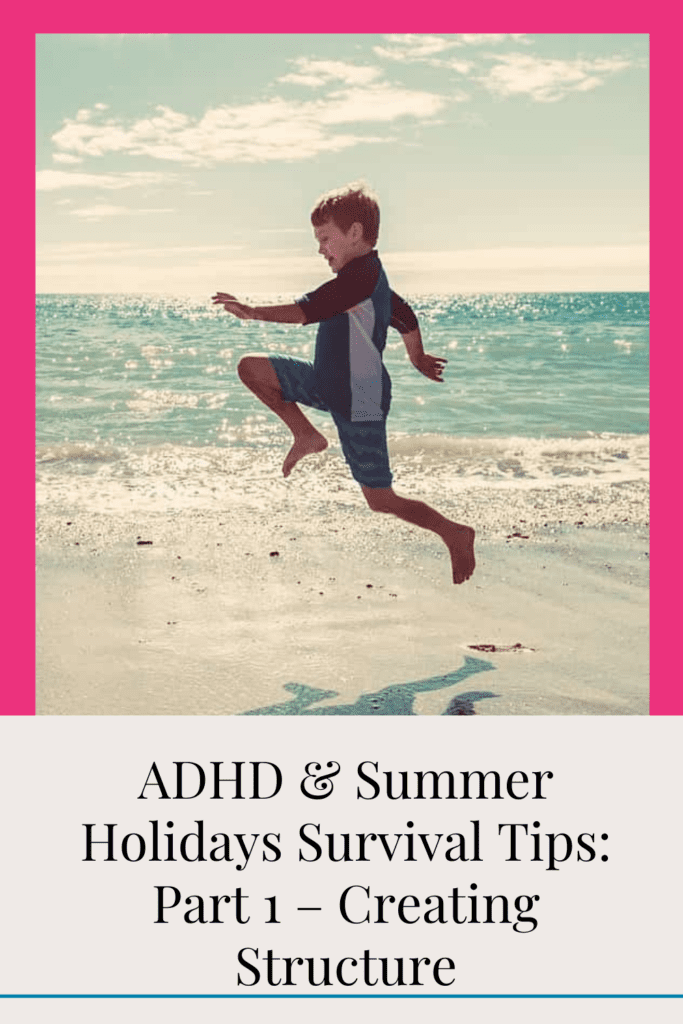Aren’t summer holidays the best? Even if as the parent, you are stuck working most of the summer it’s great to see the kids so excited and in such a great mood. Summertime leaves us wanting to make all sorts of fun plans whether it’s a week away camping or a series of staycations. But what about those ‘long lazy days of summer’, those many days that are free from exciting adventures? What if you have a child with ADHD and all the free-time has proven to be a nightmare in previous summers?
Parents jokingly tell me all the time, there’s the vision of summer and then there’s the reality. Their child with ADHD or ASD is getting into all sorts of trouble, is over-stimulated and more prone to tantrums, moodiness and meltdowns.
Parents can tend to underestimate or forget how important routine is for their child. During the school year, your child has a routine from morning to bedtime. Now of course you don’t want summer to feel like boot camp. That will only create mutiny! The key is to make a routine within the fun. Create structure around the lighter more relaxed activities. Now keep in mind, over-planning or too many activities can create the same overstimulation as boredom can if kids have no down time at all. The key is balance.
Structure and routine is something these kids absolutely need but they also have a hard time creating it or sticking to it on their own. They might even have an idea of a routine but then following through is a whole other problem. When kids with ADHD don’t have structure, and the engaging activities that go with it, they try to create the stimulation which often involves getting into trouble. Children with ADHD are more likely to end up injured, or even in the hospital during the summer months because they have less structure and are more distracted and prone to impulsive and reckless behaviour.
The solution? You guessed it.
1) Plan Activities – Free-play is great for kids and many are not getting enough. However, eight hours of free-play for a child with ADHD is a recipe for disaster for everyone involved.
Free play is necessary for developing the area of the brain responsible for executive function which is identified as one of the underlying problems in ADHD and learning disorders.
When children have free play, meaning play without unnecessary rules beyond respect and without adult interference, they are planning, problem solving, negotiating, practicing reasoning, self-regulation and self-control and essentially developing higher level skills known as critical thinking—all of which are necessary for both school and life success. Make free-play an activity but don’t make the entire summer free-play for a child with ADHD or you’re setting you and your child up for disaster.
Start by making a list of activities you can do that you can refer to throughout the summer so you can weave these activities into the routine. Involve your child in that plan. Ask them what sorts of things they would like to do. Consider what your child likes to do and what activities would be important for their well-being and development.
When actually doing the activities, as counterintuitive as it may seem, leave an activity when everyone is still having fun. Waiting until boredom, arguments and disaster strikes is the last way you want to end an activity. Even children without ADHD get irritable when they are overtired, bored or too hot so keep your child rested, cool and engaged. Give your child a heads up of how long you’re going to do that activity and then let them know “we have 20 more minutes” and then “we are going to start packing up in five minutes.” This is called front-loading and gives kids time to mentally prepare.
2) Start with Structure – Make a plan of what a typical day is going to look like. If they are going to be at a babysitter, makes sure it is someone who understands the importance of keeping your child on a routine. It doesn’t have to be like school, but there needs to be variation.
Start by making sure your child is waking up at around the same time they would be during the school year. This should be followed by breakfast and getting dressed, brushing hair and teeth etc. Once this is complete, you or your babysitter might have a routine where from 9:00-10:30 the kids get some exercise like playing soccer outside, badminton, or going to the park etc. Maybe at 10:30 they come in for a snack and have some chores to do like washing breakfast dishes, tidying their rooms or doing 20 minutes of reading. This could be followed by lunch, and then an outing like going swimming.
Balance more stimulating activities by following them with activities that allow them to rest and reset like reading, or story time. The predictability of a daily routine will reap rewards you cannot even imagine. As much as these kids can be prone to being impulsive and be adventurous, predictability helps them to know their boundaries and feel grounded.
3) Schedule Bedtime – Bedtimes tend to fall to the wayside in summer. As parents, we too are tired of enforcing the tedious bedtime routines that we do all year, but I have to say I am a stickler for sleep. Nothing seems to set off kids like lack of sleep or erratic bedtimes especially kids with behavioral issues.
These kids need a regular sleep schedule more than anything. I have found a hallmark of maintaining that routine that kids crave even in the summer is trying to maintain a similar bedtime as the school year. Of course, this may require being flexible but tools like black out blinds and a white noise machine can help kids fall asleep even in the summer months. When back-to-school starts you will thank yourself for adhering to a bedtime routine.
Stay tuned for Part 2 of this series where I will talk about how to Survive Summer Holidays by Preventing Overstimulation.


